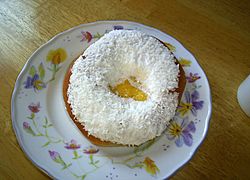School bread facts for kids
 |
|
| Type | Sweet roll |
|---|---|
| Place of origin | Norway |
| Main ingredients | yeasted dough, custard, icing, coconut |
A school bread or school bun is a yummy Norwegian sweet roll. In northern and eastern Norway, it's called Norwegian: skolebrød. In western Norway, people say skolebolle.
This tasty treat is made from a soft, yeasty dough. It has a creamy custard filling and is topped with sweet icing. To make it even better, it's often dipped in grated coconut. People used to pack it in school lunches as a dessert or sell it at bake sales. That's how it got its name!
In Arctic Norway, there's a similar bun called a solbolle. This one doesn't have icing or coconut. People eat solbolle to celebrate when the sun comes back after the long, dark polar night.
Contents
What is Skolebrød?
Skolebrød is a popular pastry from Norway. It's a type of sweet bun that's soft and fluffy. The dough is made with yeast, which helps it rise and become light.
What are the main ingredients?
The main parts of a skolebrød are:
- Yeast dough: This is the soft, bread-like base of the bun.
- Custard: A creamy, yellow filling that's sweet and smooth.
- Icing: A sweet, white glaze drizzled over the top.
- Coconut: Grated coconut flakes sprinkled on the icing.
When did Skolebrød become popular?
This special pastry first appeared in the 1950s. It quickly became a favorite treat for many Norwegians.
Why did the name change?
In the 1970s, people started talking about how much sugar kids were eating. Some thought calling a sweet, high-calorie bun "bread" might make people think it was healthy to eat every day. Because of this, the name "skolebolle" (school bun) became more common during that time. It helped show that it was more of a treat than an everyday bread.
When is School Bread Day?
In 2017, a group called the Information Office for Bread and Grain decided to create a special day for skolebrød. Now, "School Bread Day" happens every year on the last Friday before schools start their summer holidays. It's a fun way to celebrate this beloved pastry!
How do Norwegians eat Skolebrød?
It might sound funny, but Norwegians actually have different ways of eating a school bread! A survey from 2021 showed that:
- About half (50%) of Norwegians eat the bun straight across, like a regular bun.
- The other half (47%) eat around the edges first, saving the yellow custard part for the very last bite!
See also
 In Spanish: Skolebrød para niños
In Spanish: Skolebrød para niños

